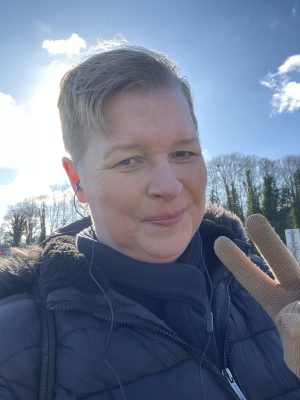This information is all about giant cell tumour of the bone (GCT). It tells you what GCT is, the symptoms to look out for, how it is found, and how it is treated.
What is a giant cell tumour?
Giant cell tumours (GCTs) are tumours that grow in the bone. They are usually not cancerous.
GCTs mostly happen in the long bones found in the arms and legs. They are more likely to affect people between the ages of 20 and 40 years old.
Even though GCT is usually not cancer, it can still grow quickly. It can damage the bone and spread into nearby soft tissue. Very rarely, a GCT may turn into cancer or may already be cancer when it is found.
Symptoms of giant cell tumours
The most common symptoms of GCT are:
- pain
- swelling around the tumour
- fractures in the bone caused by bone weakness
- limited movement.
Diagnosing giant cell tumours
A specialist doctor will diagnose GCT through a series of tests. These may include:
- questions about your medical history
- a physical examination
- a scan – taking pictures of the inside of the body using X-ray, CT or MRI
- a biopsy – taking and testing a tissue sample from the tumour.
We have more information about the different scans and tests you might have.

Before I was diagnosed, I was an international Ironman athlete, very fit and a personal trainer, so the news was devastating. Obviously, having GCT in my femur meant my leg would never be as strong as it was before or able to handle long-distance events, but I have found a way to live that makes me satisfied and fulfilled. After years of recovery and physio, I am fortunate enough to be physically able to run 10km again.
Leanne, who was diagnosed with giant cell tumour (GCT)
Treating giant cell tumours
Most people with GCT are treated with surgery, a biological therapy called denosumab, or a combination of both.
Surgery for GCT
Many people have an operation called curettage. The surgeon scrapes out the tumour from the bone. This aims to remove all the GCT cells. It usually helps keep good movement in the limb.
After the tumour is cleaned out, the surgeon will fill the hole that’s left behind. This is usually done with a bone cement or bone graft, which helps to support the bone. If the GCT has weakened your bone, it may need further support with plates and screws.
Sometimes the GCT can be aggressive or large, meaning it might damage or break the bone. In this case, you may need the entire affected area of bone removed. This might involve some reconstruction surgery to rebuild the bone.
What are the advantages and disadvantages of surgery?
The advantage of a curettage, with or without cement or bone graft, is that you keep your own joint. The disadvantage is that the risk of the tumour coming back happens in up to 50% of cases.
The advantage of surgery to remove the affected bone area is that the whole GCT is removed, and there is a very low risk of it coming back.
The disadvantage is that you may need an artificial joint replacement. You will not have the same function as you had before, and you may be at risk of infection.
In many situations, the surgeon will try curettage first. If that does not work, then you may have surgery with reconstruction.
Biological therapy for GCT
Biological therapies, also known as targeted therapies, are treatments that affect the way cells work. GCT is sometimes treated with a biological therapy called denosumab. Denusomab is given as an injection under the skin.
GCT is caused by giant cells that break down healthy bone cells and destroy the bone. Denosumab works by slowing cells down. It can stop bone damage in people who have GCT of the bone, and it can be used to shrink a GCT enough so it can be removed safely through surgery.
Most people find that any pain they have improves within a few weeks of denosumab treatment. X-rays and scans often show the tumour getting smaller. New bone may grow in the area within a few months.
What are the side effects of denosumab?
Denosumab is an effective treatment, but there are long-term side effects:
- Jawbone problems (called osteonecrosis of the jaw ), which can lead to deep ulcers
- Pain in the long bones when active
- low calcium levels in the blood (hypocalcaemia).
Because this treatment affects your bones, you’ll need to take calcium and vitamin D supplements.
Denosumab may also affect unborn babies in the womb. Because of it, it’s recommended that you do not get pregnant during treatment with denosumab.
After treatment
After treatment for GCT, you will have regular follow-up appointments for several years. Your clinical nurse specialist or key worker will tell you how often you need to come back.
At each appointment, the team will:
- ask about any symptoms
- check the area where the tumour was, usually with scans like MRI or X-ray
- check your lungs with a chest X-ray or CT scan, because GCT can sometimes spread there.
Recurrence
Sometimes GCT can come back in the same place. This is called a local recurrence. If the tumour does reappear, it is important to get treated quickly. This could involve further surgery or denosumab treatment.
You can check for recurrences yourself. The most common sign of a GCT recurrence is pain. You may also find a new swelling or a lump. If you are worried about your tumour returning, contact your doctor or nurse. They can arrange to see you sooner if needed.
Sometimes GCT can come back in other parts of the body. This is known as metastasis. If this happens, GCT most often spreads to the lungs, particularly in patients who are high-risk and are first diagnosed with an existing fracture. Treatment can include surgery to remove the tumours, or treatment with a biological therapy (denosumab).
In a very small number of cases, a GCT can turn into cancer. If this happens, your doctor will talk with you about the treatment options.
Living with GCT
Living with GCT and the side effects of treatment can be difficult. We have support to help you with your mental health, physical health, and we also have financial support. No matter what you’re worried about, we’re here to support you.
If you have questions or you need to talk to someone, our Support Line team are here for you.
More support
Call the Support Line
The Sarcoma UK Support Line is here for every person affected by sarcoma. Get in touch for friendly, expert, confidential and free advice on anything to do with sarcoma.
Join a support group
There are a number of sarcoma support groups across the UK. We have more information about support groups available online and in your local area.












